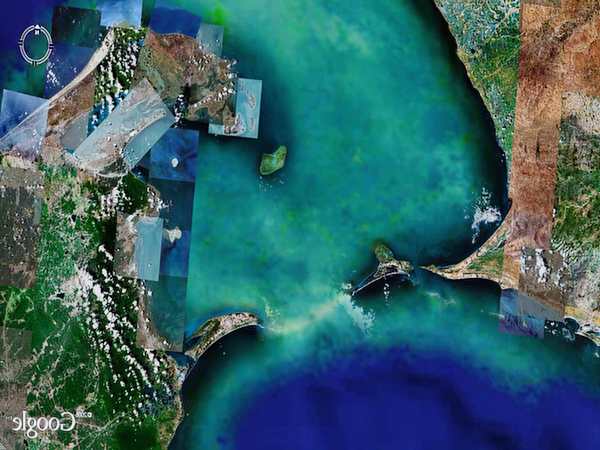NASA’s satellite images have unveiled a fascinating discovery in the Palk Strait, a mysterious ancient bridge connecting India and Sri Lanka. Known as Adam’s Bridge, this chain of shoals stretches 18 miles (30 kilometers) and exhibits a unique curvature and composition that suggest human construction. This revelation ties into the rich tapestry of legends and archaeological studies, potentially reshaping our understanding of ancient human history.
The Historical Context of Adam’s Bridge
Legends and archaeological evidence suggest that human inhabitants have been present in Sri Lanka for approximately 1.75 million years. Remarkably, the estimated age of Adam’s Bridge aligns with this timeframe. This bridge is intricately linked to the epic Ramayana, an ancient Indian narrative that describes the construction of a bridge between Rameshwaram in India and the Sri Lankan coast by Lord Rama, a revered figure believed to be an incarnation of the supreme being.
The Ramayana recounts the efforts of Lord Rama and his army of monkeys in building this bridge to rescue his wife, Sita, from the demon king Ravana. This epic, set in the Treta Yuga (over 1.7 million years ago), describes how the bridge facilitated their journey across the ocean. The discovery of Adam’s Bridge lends credence to these ancient texts and suggests that they might contain historical truths.
Archaeological Evidence and Scientific Studies
In 1894, Cyrus Thomas and Thomas Powell of the Bureau of Ethnology reported to the Smithsonian Institute about discovering large human skeletal remains in Roane County, Tennessee, and presumed Indian burial mounds in Dunlieth, Illinois. These findings highlighted the possibility of ancient civilizations with advanced engineering capabilities.
Similarly, the recent geological and geophysical surveys conducted by the Department of Earth Sciences and ocean technologists in Bharatam revealed that Adam’s Bridge is a significant geological feature. These studies indicate that the bridge’s formation resulted from tectonic activity, with uplifted blocks forming the structure. This natural phenomenon, coupled with human intervention, likely created the bridge as it appears today.
The bridge’s calcareous sandstone and coral composition further support the theory of ancient human construction. Corals, typically found growing on hard rock formations, appear in Adam’s Bridge as rounded pebbles and compact formations, suggesting they were transported and placed there intentionally. This method of construction mirrors modern-day causeways and indicates a sophisticated understanding of engineering by ancient humans.
The Spiritual and Cultural Significance
For many, the discovery of Adam’s Bridge transcends archaeological interest and enters the realm of spiritual and cultural significance. The Ramayana and other ancient texts, such as the Srimad-Bhagavatam and the Bhagavad-gita, provide detailed accounts of the bridge’s construction and its divine associations. These texts describe superhuman feats, such as controlling the Indian Ocean and constructing a floating stone bridge, attributed to Lord Rama and his army.
The Ramayana, penned by Sage Valmiki, vividly portrays the construction of the bridge with the aid of mechanical devices and the tireless efforts of Rama’s monkey army. The epic’s detailed descriptions align with the geological and archaeological findings, suggesting a convergence of mythology and historical reality.
Implications for Modern Science and History
The revelation of Adam’s Bridge holds profound implications for modern science and history. It challenges contemporary understandings of ancient civilizations and their capabilities, suggesting that advanced engineering and construction techniques existed far earlier than previously thought. The bridge’s discovery also prompts questions about other ancient structures and their potential connections to mythological accounts.
The involvement of private museums and mysterious fires, as recounted by researcher Brad Steiger, adds an element of intrigue and raises questions about the preservation and documentation of such discoveries. The Smithsonian Institution’s alleged retrieval of large skeletal remains without public record further complicates the narrative, hinting at possible efforts to suppress or control information about ancient human history.
Conclusion: Mysteries of Adam’s Bridge
Adam’s Bridge stands as a testament to the ingenuity and capabilities of ancient civilizations. The convergence of geological, archaeological, and mythological evidence presents a compelling case for its human construction and links to the epic Ramayana. As scientific investigations continue, the bridge’s discovery promises to reshape our understanding of human history and the ancient world.
For the global community, the bridge not only represents an archaeological marvel but also opens a window into the spiritual and cultural heritage of India and Sri Lanka. As research progresses, Adam’s Bridge may unlock further secrets of our past, offering insights into the lives and achievements of our ancient ancestors.
By delving into the depths of history and legend, we uncover stories that challenge our perceptions and expand our horizons. Adam’s Bridge, a remarkable blend of natural and human-made wonder, invites us to explore the mysteries of our ancient world and reflect on the enduring legacy of human ingenuity.

